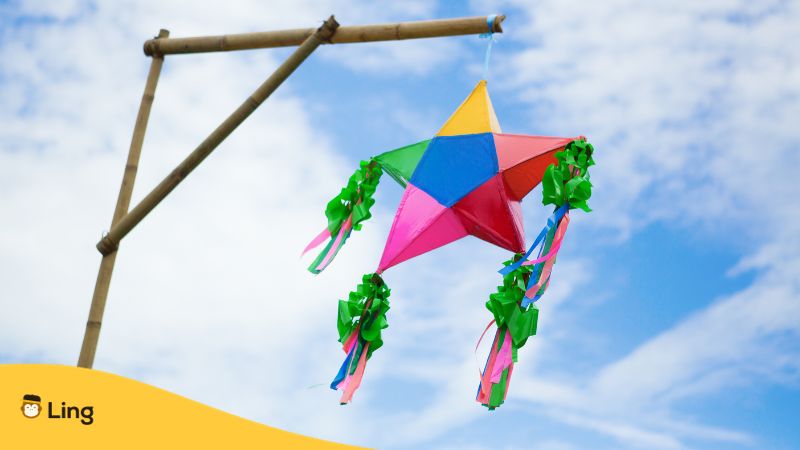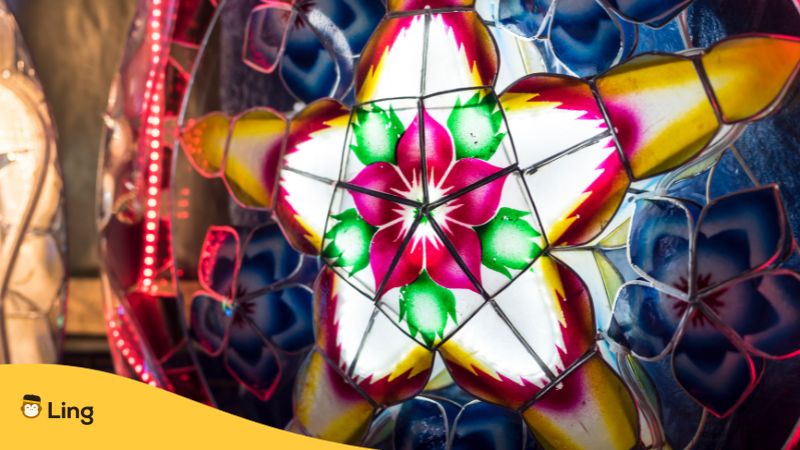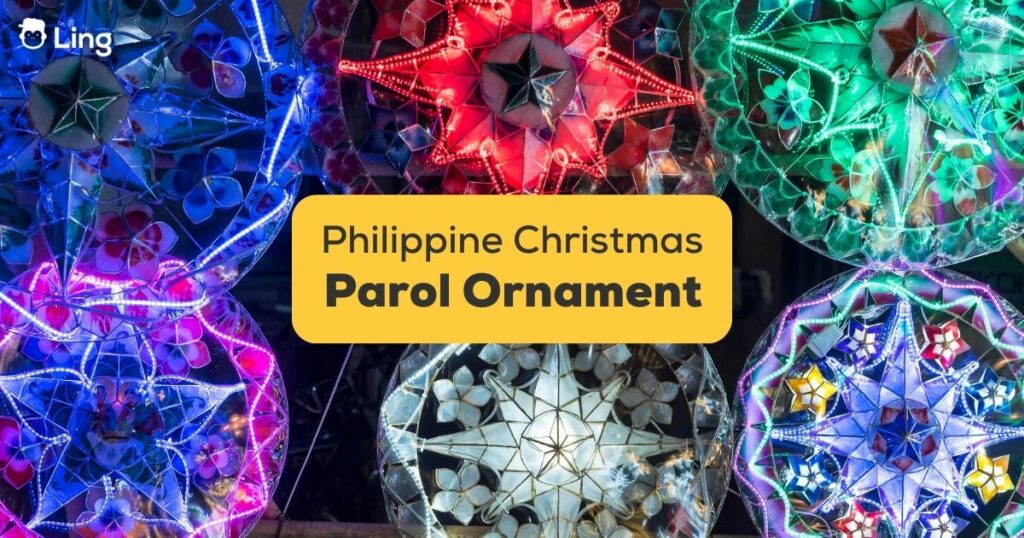Gaze upon the twinkling display of lights outside your local Catholic church or a Filipino family’s home come the Christmas season, and you’ll likely see the iconic Philippine Christmas parol, an ornate star-shaped lantern that has become a quintessential part of holiday festivities. But wait! What is this dazzling Christmas decoration (or palamuti in Tagalog) and why should you care?
Well, travelers looking to bask in some tropical holiday spirit without the snow, or Filipino Americans longing for some nostalgia from back home, learning the story behind the parol is an absolute must. You see, this glowing fixture may have originated centuries ago when lanterns lit the way during pre-dawn masses in the early Spanish colonial era. But the parol has evolved from a religious tool into a vivid symbol of the Filipino Christmas celebration, representing everything from the star of Bethlehem to the spirit of unity and hope during the most wonderful time of the year.
Curious? Let’s learn more about it in the sections below!
Table of Contents

What Is A Philippine Christmas Parol?
Looking for the best Christmas decorations that scream “Filipino” loudly? Come the -ber months in the Philippines, streets shine even brighter as star-shaped lanterns called “parol” emerge, symbolizing the coming of Christmas. And you know what’s cool about these? Well, these iconic Filipino holiday decorations trace tradition for centuries!
Parol typically takes the form of five-pointed stars crafted from bamboo slats and rice paper or papel de hapon. Flickering candles or electric bulbs illuminate the translucent panels from within, allowing vibrant stars to glow at night. Other popular renditions involve sparkling parol sculptures in rainbow colors.
The term “parol” stems from the Spanish word “farol” meaning lantern. Historically, parol-making offered a source of extra income, allowing families to save money for holiday feasts. Today, parols remain a quintessential part of Pinoy Christmas culture, often displayed in homes and prominent public exhibits.
Beyond bright embellishments, the beloved Christmas stars hold a deeper meaning. Each point represents the virtues Jesus embodies – Hope, Faith, Charity, Goodwill, and Peace. Others symbolize the Star of Bethlehem itself, guiding wise men to the nativity. Wherever displayed, cheering onlookers know beloved parol serve as hallmark heralds declaring Christ’s blessed birth while illuminating the promise of divine guidance through times of darkness.
How To Make The Philippine Christmas Parol
Want to craft an iconic symbol of Pinoy holiday cheer? Making traditional parol allows hands-on bonding for families while illuminating spaces with custom Christmas stars.
Gather materials like bamboo slats, translucent paper, string, and glow items (candles, lights). Cut the bamboo into uniform slim sticks for framing star shapes. Vary stick lengths for size preferences. Secure frames by fastening joints with string and glue.
For papier-mâché style parols, shape rice paper over the constructed forms. Curve papers neatly around frames to create five-pointed stars before gluing delicate details. Sturdier parol versions involve interweaving mats of bamboo splits called “sawali” into star-shaped placements with bold contrasting hues.
Once frameworks finish, add candles secured within glass holders or string sets of electric bulbs throughout the inner parol. This allows the intricate lanterns to emit a warm signature glow from inside the handcrafted stars. Suspend parols using hooks and nylon transparent string before displaying them proudly by windows, doorways, or on porches.
History Of The Philippine Christmas Parol
While the sparkling parol may now be associated with family gatherings around the Christmas ham and sauce-drenched pancit noodles, its origins actually date back centuries to the Spanish colonial era in the Philippines.
In the 16th century, Mexican lanterns called farolitos floated their way over to the islands, carried by sailors who used these glowing lights during pre-dawn masses in December known as misa de gallo or simbang gabi. Given the early morning hours, people needed help illuminating their walk to church through the darkness.
These lantern processions served both a practical and symbolic purpose – guiding people’s path to celebrate the coming of Jesus while representing the star of Bethlehem that led the Three Kings to the nativity.
When Spain colonized the Philippines, Filipino artisans adopted the lantern tradition, tweaking the design into the signature star shape and ornate curlicue trimmings we see today. The parol represents not just the star of Biblical lore but also the victory of light over darkness.
Beyond religious symbolism, the ubiquitous presence of parols conveys the spirit of hope, unity, and good tidings during the yuletide season. You see them just about everywhere, from shopping malls to office buildings to homes, signaling the official start of Christmas in the Philippines.
Much like the Macy’s Thanksgiving Day Parade kicks off the holidays in America, the parol ushers in a season filled with family feasts, lively parties, and nostalgia for Pinoys, whether at home or among the millions of Filipinos abroad missing their homeland.
Philippine Christmas Parol Contest
If those humble homemade holiday stars seem tiny, await the awe-striking spectacle known as Pampanga’s annual “Ligligan Parul” or Giant Lantern Festival! This incredible Pinoy tradition showcasing colossal Christmas lantern displays will leave any parol pale in comparison.
Just how giant do the glittering centerpieces reach? Past parades produced staggering star-shaped parol spanning 20 feet tall and 16 feet in diameter, composed entirely of intricate capiz shell pieces numbering in the thousands and colorful lightbulbs galore. Makes your average yuletide yard decor look Lilliputian!
The brilliant event stems from San Fernando’s long artisanal history of crafting eye-popping parol using indigenous materials like bamboo, papel de hapon (rice paper), and vibrant capiz shells. December welcomes talented teams racing to out-sparkle one another through breathtaking increased scale and detail dedicated to lantern designs accentuating beloved stars.
As the sun sets, completed gigantic structures get transported to festivals by truck before being unveiled in coordinated festivities. Over 5,000 lights adorning towering parol structures soon illuminate the night sky, synchronized to flicker and dance in dazzling rhythm to live bands and cheering spectators of all ages.

Where To See Philippine Christmas Parol Decorations
With thousands of parol displays twinkling across the islands each December, where shines the best chance to bask under glowing holiday stars?
The Festival of Lights showcases at Ayala Triangle Gardens in Makati stop passersby in their tracks through larger-than-life parol-lined walkways plus enchanting light shows completely transforming trees into technological marvels dancing to Christmas classics.
For awe-inspiring homemade statistics, head north to Pampanga any Saturday night leading up to Christmas as San Fernando erects world-record-breaking gigantic lanterns some over 40 feet high! Their annual Ligligan Parulan festival never fails to dazzle with intricate shell and bamboo mega-parol structures ornately designed by skilled neighborhood artisans.
Over To You
As neighborhoods start glittering with the familiar sight of beloved bamboo parol stars strewn across porches, take a moment to appreciate these handcrafted decor’s deeper meaning. What makes the iconic Filipino Christmas lantern far more than a quaint decorative piece is the symbolic virtues it has shone light upon for generations.
Within the parol’s flickering flames and dancing bulb lights lies a reminder to nurture the spirit behind the season. Let peace, hope, and goodwill sparkle in our hearts even after tinsel gets tucked away. For there’s always room for more joyful gatherings and traditions that bind us together in community, however we choose to herald the holidays.
Merry Christmas!
Want to learn more about the Philippines and the Tagalog language? Give Ling a try today to start learning the right way! Download it for FREE from the App Store or Play Store now!



































































